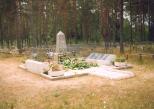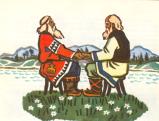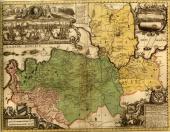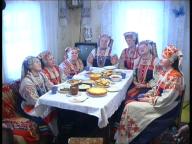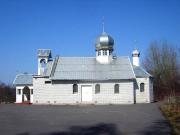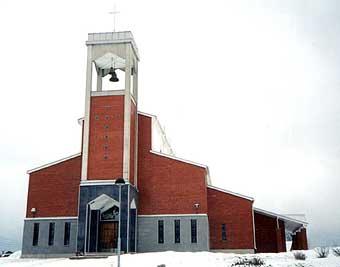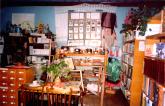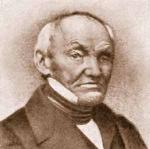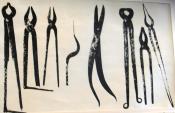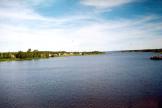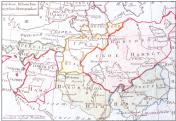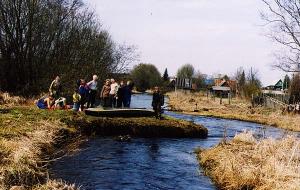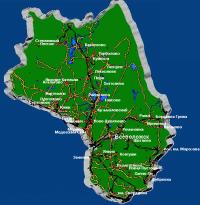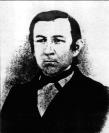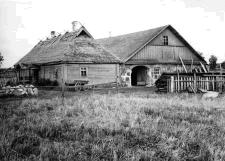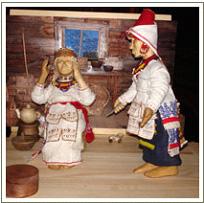Articles
/
Izhora (Izhora men)
Izhora (Izhora men)
Subject /
Ethnic culture/Ethnic communities
Subject /
Ethnic culture/Ethnic communities/
Subject /
Ethnic culture//
Izhora (Izhoras, the own native name is Izurit) is an ethnic community. Their language is related to the Baltic-Finnic subgroup of the Finno-Ugric branch of the Uralic language family. Accorging to the most widespread version the Izhora separated from South Karelian tribes in the period from the end of 1000 to the beginning of 2000 AD, they were settling in the basin of the Izora and Neva Rivers and since the period from the 11th to the 12th century they were moving along the south shore of the Gulf of Finland to the Narva River contacting with the Votes and Slavs. Since the 12th century Izhora Land was in the possession of Veliky Novgorod. Izhora men guarded borders. In 1240 Pelgusy, an Izhora elder, warned Prince Alexander Nevsky about debarkation of Swedes on the bank of the Neva River. In 1897 the number of Izhora was about 14 thousand people. They are divided into five groups differed with dialects : Soikinskaya group (the population of the Soikinsky Peninsula), Nishneluzhskaya group (the Lower Luga River), Khavasskaya group (environs of the Kovash River, in Finnish - Hevaa), Oredezhskaya group (the Upper Oredezh River) and Izhora group of the south part of Karelian Isthmus (they had been assimilated by Russian and Ingermanlandian Finns by the 20th century). In the period from 1926 to 1936 there was Soikinsky national Izhora village soviet, there were schools with teaching in Izhora language. In 1989 the number of Izhora in the Leningrad Oblast was 276 people; in the USSR the number was 820 people in all. In 2002 in the Leningrad Oblast the number of Izhora was 177 people (mainly in Soikinskaya and Ust-Luga Volost of Kingisepp District), in S.Petersburg there were 53 people and in Russian Federation there were 327 people in all. Izora's traditional occupation have been farming, animal husbandry, fishing (including ice fishing in the Luga Bay for making sprats). In the 19th - the beginning of the 20th century temporary leaving the place of residence for earning money in the regions with industry and agriculture developed and intermediate trade were spread among the Izhora men. Till the 20th century some archaic elements of women's clothes were kept: women put on two widths (aanua and hurstut), which weren't sewed together and were held up by shoulder straps, over their shirt (ryatsinya). The religious Izhora men profess the Orthodoxy. As early as the 16th century lots of Izhora men were heathens and worshiped nature objects (stones and trees). The pre-Christian elements were kept in the rites up to the 20th century. The Izhora had their own epic poetry. Elias Lönnrot used some its elements while creating "Kalavala" (a cycle about Kullervo). The most famous Izhora narrators of folk tales are Ontropo Melnikov and Larin Paraske. Some objects of Izhora's culture are presented in the expositions of the Izhora folk museum, the local history museum of Kingisepp. In Vistino and Gorki Villages there are folk groups performing songs in the Izhora language. In June 2004 in Vistino Village "Izhorsky prazdnik" ("Izhora Folk Festival") took place.
Authors
Chistyakov, Anton Yuryevich
Persons
Alexander Nevsky, Prince
Larin, Paraske
Lennorot, Elias
Melnikov, Ontropo
Geography
Leningrad Oblast, the/Kingisepp District/Gorki Village
Topographical landmarks/Gulf of Finland, the
Topographical landmarks/Izhora River, the
Topographical landmarks/Karelian Isthmus, the
Leningrad Oblast, the/Kingisepp District
Topographical landmarks/Kovashi River, the
Topographical landmarks/Luga Bay, the
Topographical landmarks/Luga River, the
Topographical landmarks/Narva River, the
Topographical landmarks/Neva River, the
Topographical landmarks/Oredezh River, the
Topographical landmarks/Soikinsky Peninsula, the
Leningrad Oblast, the/Kingisepp District/Vistino Village
Bibliography
Ингерманландская эпическая поэзия: Антология / Сост. Э.С. Киуру. Петрозаводск, 1990.
Мы живем на одной земле: Население Петербурга и Ленинградской области. СПб., 1992, 89-109
Лаанест А. Ижорские диалекты. Лингвогеографическое исследование. Таллин, 1966., 89-109
Прибалтийско-финские народы России. М., 2003., 592-620
Рябинин Е. А. Ижора // Природа. 1992. № 9., С. 82-89
Subject Index
Finns of Ingermanlandia
Izhora festival
Izhora Popular Museum, the
Kingisepp Museum od the Local History, the
Mentioned in articles:
|
hidden
|
Ayramoiset, an ethnic group of Ingermanlandia Finns
The Ayramoiset (Ayramoiset, Evremeisy, Evrimeisy) is an ethnic group of the Finns of Ingermanlandia. Descendants of the migrants of the 17th century to Ingermanlandia from the region of Euryapyae on the Karelian Isthmus. The Ayramoiset kept archaic... more
|
|
|
hidden
|
Bolshaya Izhora, urban settlement
BOLSHAYA IZHORA, an urban settlement in Lomonosov District. Population: 3,800. Located on the southern coast of the Gulf of Finland, near the Bolshaya Izhora railway station of the Oranienbaum-Kalische branch. The Chornaya Rechka river (Izhorka in... more
|
|
|
|
hidden
|
Burial grounds of the Izhora people.
Burial grounds of the Izhora people are concentrated in the Izhors tribe land in the Izhora and Neva rivers basin and on the south coast of the Gulf of Finland (see: Izhora). There are the data about 33 soil burial grounds. Excavations were made... more
|
|
|
|
hidden
|
Ethnic deportations
Ethnic deportations are forced resettlement carried out according to an ethnic signs. In 1935-36 in the Leningrad Oblast there were some activities on purging the zone of land with 22 kilometres wide at the border with Finland "from kulak and... more
|
|
|
|
hidden
|
Ethnic groups if the Leningrad Oblast
Ethnic communities of the Leningrad Oblast. The settled communities of people historically formed on the certain territory, having the common features of culture and self-consciousness expressed in the native name are called an ethnic community (or... more
|
|
|
|
hidden
|
Finno-Ugric nations
Finno-Ugric nations are ethnic communities speaking the languages of the Finno-Ugric group which is a part (together with the Samoyedic and Yukaghir groups) of the Ural (Uralic-Yukaghir) language family. Finno-Ugric nations have lived historically... more
|
|
|
hidden
|
Folklore
FOLKLORE of folks living in the Leningrad Oblast (ref. Ethnic communities in Leningrad Oblast) is multilayer polyethnic heritage which appeared as a result of rich history of the region. One of the first people to study the Veps in the period of... more
|
|
|
|
hidden
|
Ingermanlandia
INGERMANLANDIA (Swed. Ingermanland, Rus. Izhora Land or Ingria), historic and cultural region in the western part of the Leningrad Oblast (Kingisepp, Volosovo, Lomonosov, Vsevolozhsk, Gatchina, Tosno, western part of Kirovsk Districts.) The western... more
|
|
|
|
hidden
|
Izhora festival
IZHORA HOLIDAY, folk festival. The aim of the festival is to revive the culture of the Izhora. First it was held in June 2004 in Vistino Vilage on the base of Izhora Folk Museum. In 2005 Izhora Holiday was celebrated on the Day of Fisherman (the... more
|
|
|
|
hidden
|
Izhora River, the
IZHORA, river, left - hand tributary of the Neva River. Total length: 76 km. Basin area: abt. 1,000 sq. km. The river springs from Skvoritsy Village, Gatchina District. It flows across Gatchina and Tosno Districts of the Leningrad Oblast and Kolpino... more
|
|
|
|
hidden
|
Kantele
The kantele is a Baltic-Finnich stringed musical instrument played by plucking (in Finnish and Karelian - kantele, in Estonian - kannel). The similar instruments are known at Lithuanians' (kankles) and Latvians' (kokle). The kantele is like a... more
|
|
|
|
hidden
|
Kingisepp District
KINGISEPP DISTRICT, a part of Leningrad Oblast. Population: 74,300, of which, 52,100 live in the adm. center Kingisepp Town. Area: 2842.1 sq. km. It has 191 rural settlements. It was established in 1927.It borders with Lomonosov, Volosovo, and... more
|
|
|
|
hidden
|
Koltushi Rural Settlement
KOLTUSHI RURAL SETTLEMENT, a part of Vsevolozhsk District. Population: 9,000. In 1996–2005, it was an independent municipal entity Koltushi Volost, and since 1 January 2006 it has had the status of first-level municipal entity. It is located on the... more
|
|
|
|
hidden
|
Kuzyemkino Rural Library, the
THE KUZYEMKINO RURAL LIBRARY (Bolshoe Kuzyemkino Village). In 1897 a peasant community reading library at Narova volost government, in the village of Kuzyemkino, was opened . After the revolution of 1917 the village reading room functioned... more
|
|
|
|
hidden
|
Kyoppen, Pyotr Ivanovich (1793-1864), a scholar
Pyotr Ivanovich Kyoppen (Köppen) (1793-1864) was a statistician, historian. He was a corresponding member of the Saint Petersburg Academy of Science (1826), a junior scientific assistant (1837), an academician (extraordinary - 1839, ordinary -... more
|
|
|
|
hidden
|
Lomonosov District
LOMONOSOV DISTRICT. Area: 1990.8 sq. km. Population: 65,300. Established in 1927. L. D. comprises Bolshaya Izhora and Lebyazhye urban settlements and 140 rural localities. It borders St. Petersburg and Kingisepp, Volosovo, and Gatchina Districts of... more
|
|
|
|
hidden
|
Population
Population. According to the census of 2002 in the Leningrad Oblast there were 1669,205 thousand people; according to the estimate made on 1 July 2005 there were 1647,6 thousand people including the town dwellers numbering 1093,9 thousand people... more
|
|
|
hidden
|
Russians
Russians are an ethnic community, the main population of the Russian Federation. Among Russians there are some ethnic groups and ethnographic groups can be marked (e.g. Cossacks and Pomors (coast-dwellers (inhabitants of White Sea and Barents Sea... more
|
|
|
hidden
|
Singers of runes
Singers of runes (in Finnish - runonlaulajat) are performers of folk poetic works at the Baltic-Finnic nations (Karelians, Izhora, Votes, Veps), narrators of folk tales (in Finnish runo is a poem, rune). The repertoire of the singers of runes... more
|
|
|
hidden
|
Treasures
Treasures are deliberately hidden riches mostly buried by the owner. About fourty coin, coin and thing, and thing treasures were found in the Leningraf Oblast territory under different circumstances. The unique treasure of craftman tools and... more
|
|
|
|
hidden
|
Ust-Luga, settlement
UST-LUGA, a settlement in Kingisepp District. Population: 1990; apart from the Russians, Izhora and Vod families live in U.-L. and its environs. Located in the mouth of the Luga River. Adjacent to U.-L. is Krakolye village. The settlement appeared... more
|
|
|
|
hidden
|
v. Sankt-Peterburg Gubernia, the
ST. PETERSBURG GUBERNIA, historic adm. and territorial unit of Russia. Established in 1708 by the decree of Peter I subdividing Russia into eight gubernias. It included the areas of the current Leningrad, Novgorod, Pskov, and Tver Oblasts, and... more
|
|
|
|
hidden
|
Volosovo District
VOLOSOVO DISTRICT, a part of Leningrad Oblast. Area: 2680.5 sq. km. Population: 46,900. Adm. center: Volosovo Town. The district comprises Kikerino urban settlement, and 202 rural localities. It borders Kingisepp, Lomonosov, Gatchina, and Luga... more
|
|
|
|
hidden
|
Vsevolozhsk District
VSEVOLOZHSK DISTRICT, a part of Leningrad Oblast. Area: 2945.4 sq. km. Population: 215,200. Adm. center: Vsevolozhsk Town. Comprises Sertolovo Town, six urban settlements (Dubrovka, settlement named after Morozov, settlement named after Sverdlov,... more
|
|
|
|
hidden
|
Yevropeus, Daniel (1820-18884), a scholar
David Emmanuel Daniel Europaeus (in Finnish - Taneli; in Russian - David Petrovich) (1820-1884) was a folklorist, archaeologist. Ethnographer. He was born in the family of a pastor in Olkkola Farmstead of the parish of Savitaipale of the Vyborg... more
|
|
|
|
hidden
|
|
hidden
|
|
hidden
|
|
hidden
|
|
hidden
|
|
hidden
|
|
hidden
|
|
hidden
|
|
hidden
|
|
hidden
|
|
hidden
|
|
hidden
|
|
hidden
|
|
hidden
|
|
hidden
|
|
hidden
|
|








